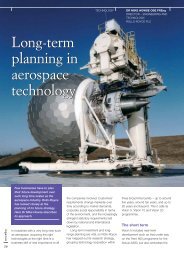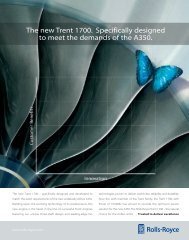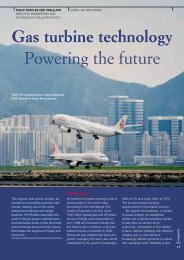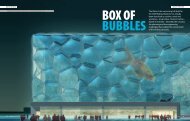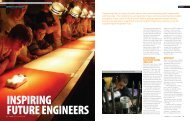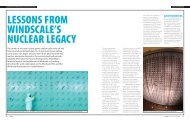MACROBERT AWARD 2009 - Ingenia
MACROBERT AWARD 2009 - Ingenia
MACROBERT AWARD 2009 - Ingenia
Create successful ePaper yourself
Turn your PDF publications into a flip-book with our unique Google optimized e-Paper software.
<strong>MACROBERT</strong> <strong>AWARD</strong> <strong>2009</strong> FINALIST<br />
TARSIER DEBRIS DETECTION SYSTEM<br />
QINETIQ<br />
Debris on runways is a critical factor in airport safety and costs operators<br />
around $4 billion globally each year in damage to aircraft engines. In response<br />
to this problem, technology company QinetiQ has created Tarsier, a system<br />
that revolutionises the way airport operators inspect their runways, leading to<br />
improved safety, more efficient operations, and greener airports.<br />
Foreign objects and debris<br />
(FOD) left on airport runways<br />
pose a significant safety risk,<br />
as seen with the loss of a<br />
Concorde aircraft in July<br />
2000 after it ran over a piece<br />
of metal on take-off from<br />
Paris Charles de Gaulle airport.<br />
Runways are typically inspected<br />
for FOD by eye from a moving<br />
vehicle four times a day.<br />
This method, however, is not<br />
ideal as it leaves large time<br />
gaps between inspections<br />
and there are difficulties<br />
inspecting at night.<br />
DEVELOPMENT<br />
Despite the shortcomings<br />
of visual inspections, there<br />
has never been a technical<br />
alternative. The Tarsier system<br />
changes that by allowing<br />
runways to be monitored<br />
continuously day and night.<br />
Typically, two or three static<br />
radar towers are required to<br />
cover a complete runway,<br />
24 hours a day, in almost<br />
any weather.<br />
At the core of the Tarsier<br />
system is a new millimetre<br />
wave radar designed by<br />
QinetiQ specifically for FOD<br />
detection. Using an innovative<br />
and patented technique, it<br />
offers higher resolution, clarity,<br />
and accuracy than any other<br />
airport radar. It is capable of<br />
imaging items the size of a steel<br />
bolt at up to a kilometre away.<br />
INNOVATION<br />
To allow an operator to assess<br />
the risk that an item poses,<br />
Tarsier includes a cued camera<br />
– a high magnification lens<br />
with colour and near-infra red<br />
cameras, along with a unique<br />
infra red illuminator for use<br />
in darkness. It is critical that<br />
the illuminator is safe to the<br />
naked eye, yet has the ability<br />
to ‘light up’ small objects from<br />
a distance. The novel design<br />
through which this is achieved<br />
is the subject of a current<br />
patent application.<br />
A ‘smart’ element of the<br />
system can automatically<br />
discriminate FOD from the<br />
background, through the<br />
use of patented signal<br />
processing. The operator<br />
can then visually identify FOD<br />
and determine whether or not<br />
it presents a threat to aircraft.<br />
Tarsier is able to detect metal,<br />
plastic, glass, rubber, and<br />
organic matter to within a few<br />
metres and provide accurate<br />
GPS coordinates for quick<br />
retrieval.<br />
COMMERCIAL<br />
SUCCESS<br />
QinetiQ’s Tarsier is the world’s<br />
first fully operational FOD<br />
detection system. The first<br />
system was sold to Vancouver<br />
International in 2006, and<br />
installations at Dubai, Doha,<br />
Heathrow, Providence Rhode<br />
Island, and RAF Boscombe<br />
Down have followed. The<br />
proving of Tarsier, technically<br />
and as a commercial<br />
proposition, has led aviation<br />
regulators in the US and<br />
Europe to begin planning the<br />
widespread introduction of<br />
FOD detection systems.<br />
The safety benefits to the<br />
travelling public that Tarsier<br />
brings are clear: constant<br />
inspection of the runway,<br />
rather than inspecting once<br />
every six hours, dramatically<br />
reduces the risk posed by FOD.<br />
In its two years in operation at<br />
Vancouver, Tarsier has found<br />
over 400 items, including<br />
several classed as ‘posing<br />
significant risk’.<br />
For further information, see<br />
www.qinetiq.com<br />
Two to three Tarsier towers continuously scan an airport runway to detect<br />
foreign objects and debris © QinetiQ<br />
16 INGENIA ISSUE 39 JUNE <strong>2009</strong>



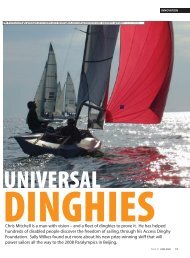

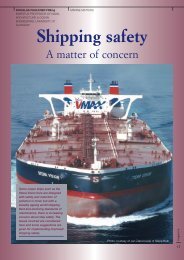
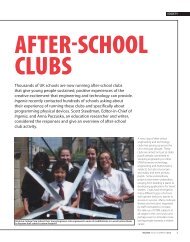

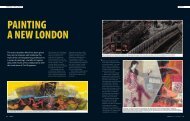
![[322/03] Francke - Ingenia](https://img.yumpu.com/23411337/1/184x260/322-03-francke-ingenia.jpg?quality=85)

